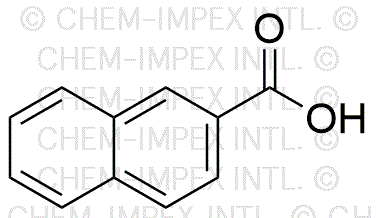2-Naphthoic acid is widely utilized in research focused on:
- Pharmaceuticals: It serves as an intermediate in the synthesis of various drugs, enhancing the efficiency of drug development processes.
- Dyes and Pigments: This compound is used in the production of dyes, particularly in textiles, providing vibrant colors with excellent stability.
- Polymer Chemistry: It acts as a plasticizer and modifier in polymer formulations, improving flexibility and durability in materials like plastics and resins.
- Analytical Chemistry: Employed as a reagent in various analytical techniques, it aids in the detection and quantification of other compounds, ensuring accurate results in research.
- Organic Synthesis: It is a key building block in organic synthesis, facilitating the creation of complex molecules in fields such as agrochemicals and specialty chemicals.
General Information
Properties
Safety and Regulations
Applications
2-Naphthoic acid is widely utilized in research focused on:
- Pharmaceuticals: It serves as an intermediate in the synthesis of various drugs, enhancing the efficiency of drug development processes.
- Dyes and Pigments: This compound is used in the production of dyes, particularly in textiles, providing vibrant colors with excellent stability.
- Polymer Chemistry: It acts as a plasticizer and modifier in polymer formulations, improving flexibility and durability in materials like plastics and resins.
- Analytical Chemistry: Employed as a reagent in various analytical techniques, it aids in the detection and quantification of other compounds, ensuring accurate results in research.
- Organic Synthesis: It is a key building block in organic synthesis, facilitating the creation of complex molecules in fields such as agrochemicals and specialty chemicals.
Documents
Safety Data Sheets (SDS)
The SDS provides comprehensive safety information on handling, storage, and disposal of the product.
Product Specification (PS)
The PS provides a comprehensive breakdown of the product’s properties, including chemical composition, physical state, purity, and storage requirements. It also details acceptable quality ranges and the product's intended applications.
Certificates of Analysis (COA)
Search for Certificates of Analysis (COA) by entering the products Lot Number. Lot and Batch Numbers can be found on a product’s label following the words ‘Lot’ or ‘Batch’.
*Catalog Number
*Lot Number
Certificates Of Origin (COO)
This COO confirms the country where the product was manufactured, and also details the materials and components used in it and whether it is derived from natural, synthetic, or other specific sources. This certificate may be required for customs, trade, and regulatory compliance.
*Catalog Number
*Lot Number
Safety Data Sheets (SDS)
The SDS provides comprehensive safety information on handling, storage, and disposal of the product.
DownloadProduct Specification (PS)
The PS provides a comprehensive breakdown of the product’s properties, including chemical composition, physical state, purity, and storage requirements. It also details acceptable quality ranges and the product's intended applications.
DownloadCertificates of Analysis (COA)
Search for Certificates of Analysis (COA) by entering the products Lot Number. Lot and Batch Numbers can be found on a product’s label following the words ‘Lot’ or ‘Batch’.
*Catalog Number
*Lot Number
Certificates Of Origin (COO)
This COO confirms the country where the product was manufactured, and also details the materials and components used in it and whether it is derived from natural, synthetic, or other specific sources. This certificate may be required for customs, trade, and regulatory compliance.


